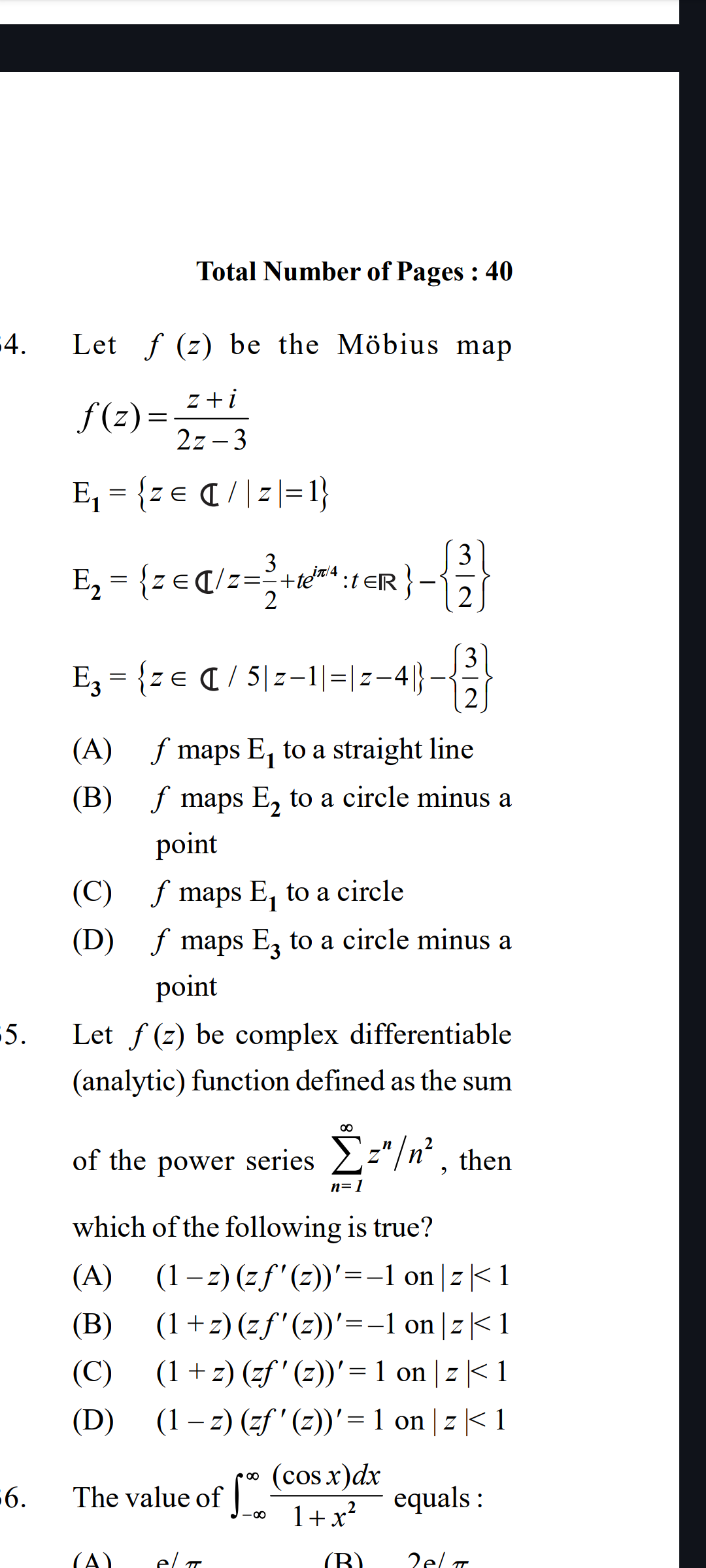See processed text.

Understand the Problem
The image contains three math questions. The first question asks about the mapping properties of a Möbius transformation applied to specific sets in the complex plane. The second question involves a complex differentiable function defined by a power series and asks to identify the correct relationship between the function and its derivative. The third question asks for the value of a definite integral involving a cosine function.
Answer
Möbius Transformation: (C) and (D) Power Series: (D) Definite Integral: $\frac{\pi}{e}$
Answer for screen readers
Möbius Transformation: (C) and (D) Power Series: (D) Definite Integral: $\frac{\pi}{e}$
Steps to Solve
Problem 1: Möbius Transformation
-
Analyze the properties of Möbius transformations:
Möbius transformations map circles or lines to circles or lines. The set $E_1 = {z \in \mathbb{C} : |z| = 1}$ is a circle (specifically, the unit circle). Therefore, $f(E_1)$ will be either a circle or a line. To determine which, we can check if the image of $z=\infty$ is finite. Since $f(z) = \frac{z+i}{2z-3}$, $f(\infty) = \frac{1}{2}$, which is finite. Since $z= \infty$ is not in $E_1$ we can conclude that $f(E_1)$ will be a circle. We can see that option (C) aligns.
-
Consider $E_2$ :
$E_2 = {z \in \mathbb{C} : z = \frac{3}{2} + te^{i\pi/4}, t \in \mathbb{R}} - {\frac{3}{2}}$. This represents a straight line passing through $3/2$ with an angle of $\pi/4$ with respect to the real axis, minus the point $3/2$. The Mobius transformation $f(z) = \frac{z+i}{2z-3}$ has a pole at $z=3/2$. As such, this point will be mapped to infinity. So, $f(E_2)$ will be a circle or a line, and since $\frac{3}{2}$ is excluded from $E_2$ its image $f(3/2)$ is excluded from the image $f(E_2)$, which in this case is $f(3/2)= \infty$. Therefore, $f(E_2)$ is a circle or line, minus a point.
To determine whether it's a circle or a line, examine the function $f(z)$. If $3/2$ were included in $E_2$, then $E_2$ would be a line that ends up mapping to a circle $f(E_2 \cup {3/2})$. Now, if we let $E_2$ be the line $E_2 \cup {3/2}$ with ${3/2}$ excluded we have a circle with $f(3/2) = \infty$ excluded. Since infinity is on the image of $E_2$ then the set $f(E_2)$ is actually a line. Since $3/2$ is excluded from $E_2$, $\infty$ is excluded from the line $f(E_2)$. Therefore, $f(E_2)$ is a line minus a point. We can eliminate (B).
- Consider $E_3$: $E_3 = {z \in \mathbb{C} : 5|z-1| = |z-4|} - {\frac{3}{2}}$. This represents a circle, excluding the point ${3/2}$. Since Möbius transformations map circles to circles or lines, $f(E_3)$ will be a circle or a line, possibly excluding a point. Note that $3/2$ is excluded from $E_3$.
First, determine whether $5|z-1| = |z-4|$ is a circle
$5|z-1| = |z-4|$ $25(z-1)(\overline{z}-1) = (z-4)(\overline{z}-4)$ $25(z\overline{z} -z -\overline{z} + 1) = z\overline{z} -4z-4\overline{z}+16$ $24z\overline{z} -21z -21\overline{z} + 9 = 0$ $z\overline{z} - \frac{7}{8}z - \frac{7}{8}\overline{z} + \frac{3}{8} = 0$ $(z - \frac{7}{8})(\overline{z} - \frac{7}{8}) - (\frac{7}{8})^2 + \frac{3}{8} = 0$ $|z - \frac{7}{8}|^2 = \frac{49}{64} - \frac{24}{64} = \frac{25}{64}$ $|z - \frac{7}{8}|^2 = (\frac{5}{8})^2$ This is, indeed, a circle. Since $3/2$ is excluded from $E_3$, its image under f is not in f($E_3$). $f(3/2) = \infty$, since $z=3/2$ is a pole of $f(z)$. Hence f($E_3$) is a circle minus a point. We can see that option (D) aligns.
Problem 2: Power Series
-
Find the derivative $f'(z)$: Given $f(z) = \sum_{n=1}^{\infty} \frac{z^n}{n^2}$, the derivative is $f'(z) = \sum_{n=1}^{\infty} \frac{nz^{n-1}}{n^2} = \sum_{n=1}^{\infty} \frac{z^{n-1}}{n}$.
-
Calculate $zf'(z)$: $zf'(z) = z \sum_{n=1}^{\infty} \frac{z^{n-1}}{n} = \sum_{n=1}^{\infty} \frac{z^n}{n}$.
-
Find the derivative of $zf'(z)$: $(zf'(z))' = \sum_{n=1}^{\infty} \frac{nz^{n-1}}{n} = \sum_{n=1}^{\infty} z^{n-1} = \sum_{n=0}^{\infty} z^n = \frac{1}{1-z}$ for $|z| < 1$ using the formula for a geometric series.
-
Compute $(1-z)(zf'(z))'$: $(1-z)(zf'(z))' = (1-z) \cdot \frac{1}{1-z} = 1$.
Problem 3: Definite Integral
-
Use complex analysis: Consider the integral $\int_{-\infty}^{\infty} \frac{\cos(x)}{1+x^2} dx$. We evaluate $\int_{-\infty}^{\infty} \frac{e^{ix}}{1+x^2} dx$ and take the real part.
-
Apply Residue Theorem: Let $f(z) = \frac{e^{iz}}{1+z^2}$. The poles are at $z = \pm i$. The pole in the upper half-plane is $z=i$. The residue at $z=i$ is $$Res(f,i) = \lim_{z \to i} (z-i) \frac{e^{iz}}{(z-i)(z+i)} = \frac{e^{i(i)}}{i+i} = \frac{e^{-1}}{2i}$$
-
Evaluate the integral: By the Residue Theorem, $\int_{-\infty}^{\infty} \frac{e^{ix}}{1+x^2} dx = 2\pi i \cdot Res(f,i) = 2\pi i \cdot \frac{e^{-1}}{2i} = \frac{\pi}{e}$.
-
Take the real part: Since $\int_{-\infty}^{\infty} \frac{e^{ix}}{1+x^2} dx = \int_{-\infty}^{\infty} \frac{\cos(x)}{1+x^2} dx + i \int_{-\infty}^{\infty} \frac{\sin(x)}{1+x^2} dx$. The real part is $\int_{-\infty}^{\infty} \frac{\cos(x)}{1+x^2} dx = \frac{\pi}{e}$.
Möbius Transformation: (C) and (D) Power Series: (D) Definite Integral: $\frac{\pi}{e}$
More Information
Mobius transformations are powerful tools in complex analysis, mapping circles to circles or lines. The residue theorem simplifies the calculation of certain definite integrals by relating them to the residues of the function at its poles.
Tips
- For the Möbius transformation problem, a common mistake is not recognizing that Möbius transformations map circles and lines to circles and lines.
- For the power series problem, a mistake is differentiating/manipulating the power series incorrectly.
- For the integration problem, one could make mistakes when calculating the residues or when applying the residue theorem. Forgetting to take the real part at the end is also possible.
AI-generated content may contain errors. Please verify critical information